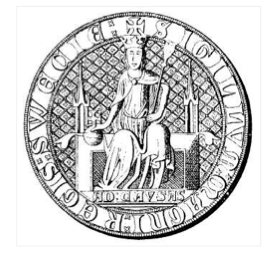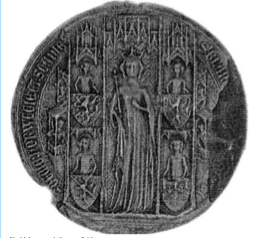Chapter 15. Royal Audiences [August 31, 1347]
Cultural Explanations
 |
Chapter 15. Royal Audiences [August 31, 1347] Cultural Explanations |
|
 |
In this chapter Bávlos has interviews with both Queen Blanche and King Magnus. |
| Queen Blanche, Duke Bengt, King Magnus, Lady Birgitta |
In this chapter, we hear Birgitta's vision for a crusade against the Orthodox of Novgorod. Bávlos meets both King Magnus Eriksson and Queen Blanche and obtains their permission to continue his trek southward toward the city of Avignon.
The details presented regarding the planned crusade are drawn directly from texts of Birgitta's visions. Birgitta enjoined her kinsman to mount a holy crusade, i.e., one that would not involve any mercenaries or include any secondary economic motivations. She also called for the king to engage the enemy in a theological debate before beginning any battle. In 1347, Magnus appears to have been wholly committed to this undertaking, although he did begin to engage mercenary troops after finding little support for the venture from among the knights of Norway. It is doubtful that Magnus ever imagined the crusade without some thought of its possible economic advantages: securing and extending the eastern border of Sweden had long been an important goal for Swedish monarchs, one which carried the promise of greater revenues and power if the Orthodox Novgorodians could only be driven back. Wars are seldom fought for purely idealistic reasons, in the medieval period or today.
 |
 |
| Seal of King Magnus | Seal of Queen Blanche, c. 1340 |
The two monarchs depicted in this chapter are among the most controversial in Sweden's stormy royal history. King Magnus IV Eriksson (1316—74) was 31 years old in 1347. He had come to the throne as a little child in 1319, and in the early years of his reign his mother and grandmother ruled in his stead, as noted in the cultural information for Chapter 8. In adulthood, however, Magnus took control of the throne himself and ruled with a good deal of turbulence. He expanded the realm by acquiring the province of Skåne, but spent wildly on the crusade against Novgorod which eventually proved an utter failure.
In 1334, after a courting expedition to the Low Countries, Magnus married Blanche (Blanka) of Namur (c. 1320—63), a woman with ties to the French royal family. She was 27 years old in 1347. Blanche was a niece of Robert III d'Artois, a major instigator of the Hundred Years' War. In Swedish folk tradition she was remembered fondly, and this image is reflected in Albert Edelfelt's late nineteenth-century painting of the queen with one of her sons.
 |
| Albert Edelfelt's sympathetic portrayal of Queen Blanche: Drottning Blanka, 1877. |
King Magnus took an inordinate interest in a young nobleman named Bengt Algotsson (c. 1330—60), who was rumored to have had affairs with both Blanche and Magnus. In 1353, Magnus did indeed name Bengt Duke of Finland, a title which led to much grumbling and envy among the other royal advisors to the king. Magnus acquired the pejorative nickname Magnus smek, a term that means to pet or stroke. In the chapter, I depict Magnus patting Bávlos's head as a reference to this nickname.